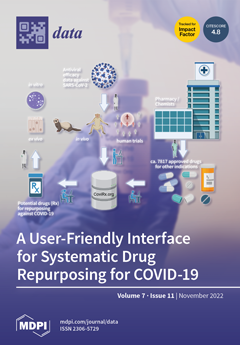Open AccessData Descriptor
CoviRx: A User-Friendly Interface for Systematic Down-Selection of Repurposed Drug Candidates for COVID-19
by
Hardik A. Jain, Vinti Agarwal, Chaarvi Bansal, Anupama Kumar, Faheem, Muzaffar-Ur-Rehman Mohammed, Sankaranarayanan Murugesan, Moana M. Simpson, Avinash V. Karpe, Rohitash Chandra, Christopher A. MacRaild, Ian K. Styles, Amanda L. Peterson, Matthew A. Cooper, Carl M. J. Kirkpatrick, Rohan M. Shah, Enzo A. Palombo, Natalie L. Trevaskis, Darren J. Creek and Seshadri S. Vasan
Cited by 3 | Viewed by 3855
Abstract
Although various vaccines are now commercially available, they have not been able to stop the spread of COVID-19 infection completely. An excellent strategy to get safe, effective, and affordable COVID-19 treatments quickly is to repurpose drugs that are already approved for other diseases.
[...] Read more.
Although various vaccines are now commercially available, they have not been able to stop the spread of COVID-19 infection completely. An excellent strategy to get safe, effective, and affordable COVID-19 treatments quickly is to repurpose drugs that are already approved for other diseases. The process of developing an accurate and standardized drug repurposing dataset requires considerable resources and expertise due to numerous commercially available drugs that could be potentially used to address the SARS-CoV-2 infection. To address this bottleneck, we created the CoviRx.org platform. CoviRx is a user-friendly interface that allows analysis and filtering of large quantities of data, which is onerous to curate manually for COVID-19 drug repurposing. Through CoviRx, the curated data have been made open source to help combat the ongoing pandemic and encourage users to submit their findings on the drugs they have evaluated, in a uniform format that can be validated and checked for integrity by authenticated volunteers. This article discusses the various features of CoviRx, its design principles, and how its functionality is independent of the data it displays. Thus, in the future, this platform can be extended to include any other disease beyond COVID-19.
Full article
►▼
Show Figures





